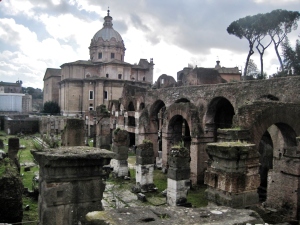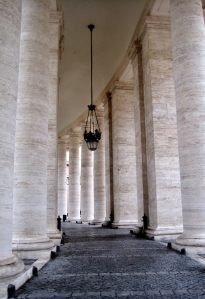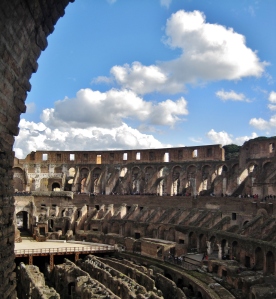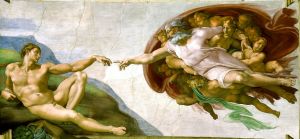I recently returned from a short trip to Rome, a city rooted with ancient ruins and umbrella pines, and while it seemed to be inhabited mostly by determined men from Bangladesh, I loved it. See, Rome is big. And I mean big as in expansive but also regarding grandeur: every building seemed to contain many archaic levels, every horse statue fit only for riders of gargantuan size. It is natural for a place like this to produce something like awe in travelers like me.  Possession
Possession
As we began our tour for the day, our group embarked with the ingredients of tourists: a map of the city, too many euros, and our cameras weighing down our necks or jacket pockets. We started at Capitoline Hill, one of the seven hills of Rome and had a guided tour through the Forum. We simultaneously lifted our arms to snap a picture of the ruins, of the pillars, of the skyline because they were ancient and beautiful and we all certainly wanted to remember them, to hold onto them. Not quite as drastically as the ancient Romans sought to conquer and control a large part of the European continent, as traveler and writer John Ruskin identified, part of being human is wanting to possess beauty. Photography seems an initially convenient medium for capture as it offers an immediate result with accurate proportions and depictions of reality. While Ruskin was originally a fan of daguerreotypes, he soon realized that practitioners of this new art were replacing actual sight and study of place for a fleeting click of a camera.
As my last post highlighted the importance of learning how to see, I connected with Ruskin’s goal of teaching people how to see through drawing, not so that they will become better artists but so they will learn how to love their surroundings. I constantly see people around me looking only through the lens on their camera, taking a picture and moving on, scarcely looking up. And I have been guilty of this myself but I have recently been frustrated by the pictures I take. They do not capture the depth that I need in order to fully possess the beauty I see and I am often left with a small image that is flat and seems to represent limitations more than the vastness of the original scene.
Robert Pirsig also writes about this in Zen and the Art of Motorcycle Maintenance, comparing the act of looking out of a car window to watching TV, all confined “boringly in a frame”. Pirsig and his extensive values stem from the openness of experience, of being completely a part of surroundings and existing “in the scene”. And while Ruskin might have challenged Pirsig to make more frequent stops and certainly would have added a sketchbook and pencils to the list of vital travel supplies, I think they both would have agreed with Alain de Botton in The Art of Travel when he says:
“We can see beauty well enough by just opening our eyes, but how long this beauty will survive in memory depends on how intentionally we have apprehended it.”
Continuing with our tours the next day, we embarked on an incredible journey through the streets of the Vatican Necropolis, through long underground roads that gave a new meaning to the term “dead end”. It was humid and quiet and I loved that I could touch everything: walls, engravings, the smooth marble of sarcophagi that represented entire bygone generations. And then we moved up to Saint Peter’s Basilica, craning our heads back in order to take in as much as possible. I am still having a hard time contemplating the exact magnitude of each detail of the walls and ceiling, and because of my realizations of the cameras restrictions during the previous day, I didn’t even dare take a picture of the inside. It was completely enough to just wonder at every aspect of the basilica’s glory.
The Sistine Chapel
After slugging through the rain and entering the labyrinthine Vatican Museum, full of rooms of tapestries, sculpture, and art from every movement, I finally got to what I really wanted to see: the famous Sistine Chapel. I packed myself into the space along with a hundred other people, shuffling along and waiting until I could get a seat along the edge of the room. Sitting, I finally looked up at Michelangelo’s ceiling. I was incredibly disappointing by the whole thing, extending down to Botticelli’s frescoes and the papal conclave. The people who had come to view this religious space scuffled along like they were part of a current, only moving rhythmically, systematically and were occasionally shocked into silence by the stern voice of the museum guard whose reprimanding hollers were as distinctive as the green parrots I had tried to spot outside. I left with a frown on my face.
I suppose I was so disappointed because I found there to be a striking lack of illumination, both physically as the room was surprisingly dimly lit, and mentally as some sort of understanding evaded me. I am not sure if I went there expecting to gain some sort of comprehension regarding the glory of either God or the greatly artistic space but I left thinking that it was smaller, less complex, and in some ways, more human than I thought it would have been. I tried to give the paintings more attention in my mind, focusing on small parts at a time but when I looked back at the whole picture, I still felt a little bit cheated by the previously boasted splendor. I again thought back to de Botton and applied the inverse of his words:
“Many places strike us as beautiful not on the basis of aesthetic criteria – because the colours match or symmetry and proportion are present—but on the basis of physiological criteria, inasmuch as they embody a value or mood of importance to us.”


